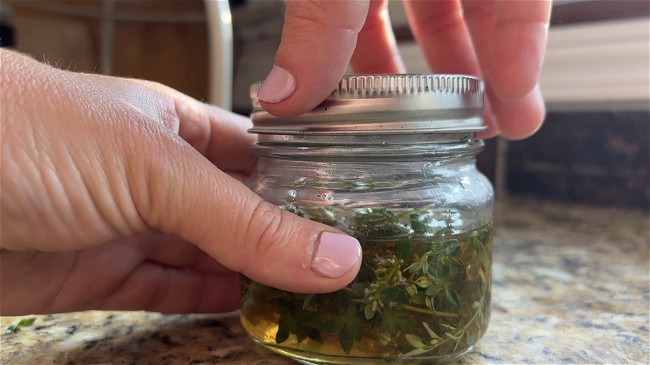Grow, Harvest, & Preserve Thyme
Thyme and Lemon Thyme are one of my favorite herbs to grow, harvest, and preserve.

Why grow Thyme?
- It tastes amazing
- It smells divine
- Immunity Booster
- Helping to alleviate cough
- Disinfecting
- Repelling pests in your home and garden
- Aromatherapy
- Boosting mood
- Preventing bacterial infections
- It's easy to preserve for future use.
- And as most herbs do, it has many medical qualities.
Plant Features & Where to Grow:
Thyme is also a perennial plant that will return yearly, making it a great addition to a permanent kitchen or herb garden.
This herb likes lots of sunlight and doesn't like "wet feet." In other words, make sure you plant it in a place that will drain well. It grows low and wide and can grow to become decently large. So, consider these things when thinking about where to place in your garden. It also, produces flowers that pollinators love.
- Growing from Seed: It's hard to grow Thyme from seeds because of slow, uneven germination.
- Buy Plants: It's easier to buy plants from a garden center.
- Propagate: Take some cuttings from a friend. Then you can propagate from cuttings in the future!

How to Use:
In the Kitchen
My favorite way to use this herb is in the kitchen!
It is excellent as a stand-alone herb. I especially love lemon thyme with any chicken dish. But, of course, it is also great in rubs, herb salts, and mixed spices.
You can also use herb salt as a way to preserve Thyme. (Blog link here)
Thyme Infused Honey
A Thyme infused honey is a great mild cough & cold natural remedy.
What you need: (Printable Recipe Below)
- Half Pint Jar
- Local Honey
- Thyme Leaves/Sprigs

Step 1: Fill a half-pint jar halfway with fresh Thyme leaves and flowers.
Step 2: Gently warm a batch of raw honey to extract the Thyme's properties better.
I usually skip this step because switching the honey from pot to jar is messy. You can't overheat the honey above 110° F, or it will kill the honey's enzymes that give it medicinal benefits.
Step 3: Add enough honey to the jar to cover the herbs.
Step 4: Place in a warm spot, like a warm/sunny window seal, where it will steep for about two weeks.
Check your jar; if the honey tastes and smells strongly of Thyme, it is finished.
You can leave the leaves in or strain them out. I like how the leaves look in the honey; it helps me visually know the infusion. Once again, it's less messy and less honey wasted if you leave them in.
How to store your infused honey:
You will want to keep it in a cool place. You can even place it in your refrigerator. Either way, it should last several months.
How to use your infused honey:
You can take a teaspoonful by mouth. Add to your morning coffee, which I do to my mushroom coffee daily. It is also good with oatmeal.
Flower Bouquets:
Add Thyme sprigs into bouquets for a soft, whimsical look. The tiny flowers add sweetness to the arrangement.
It will also add a delicious smell to your bouquet while helping keep pesky gnats and flies away!
Visually pleasing while keeping pests away, you can't bet that!
How to Preserve Thyme:
Thyme is a very easy herb to dry. You can place the stems in a drying rack, which will be ready in about two weeks.

Then place the dried leaves in a jar. Store in a cool dark place.

Make sure that you label your jars! Many herbs look a like once dry and you can easily get them mixed up.
I created my own printable labels for my home apothecary. I have the one featured and two other designs available in our shop. Grab Your Labels Here

Watch my Thyme harvest, how I dry Thyme, and create a Thyme infused honey.
Thanks for visiting the Wildwood Wonder Cottage Homestead!


